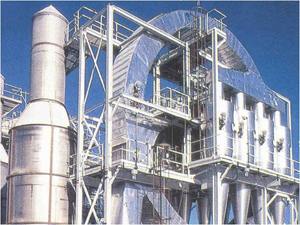
Application
Flash dryers are used to dry wetted materials such as corn starch. The material to be dried is metered into a hot airstream generated by an oil or gas-fired heater. The product dries as it is transported along the dryer ducting. This ducting terminates in a bank of cyclones or other separators which remove the dried product from the airstream. Secondary separators such as dust collectors may also be used.
Hazard
If the material being handled by a process is combustible, then the dust it generates is likely to be explosive, which can cause a combustible dust explosion. In flash drying systems, the material being processed becomes more sensitive to ignition as it passes down the dryer and loses its moisture. The minimum ignition energy of the dried product can be low enough to present the threat of ignition by static discharge. Additionally, material adhering to the walls of the dryer can absorb enough energy to self-ignite. The resulting deflagration generates high flame speeds and rapidly produces destructive pressures due to the pressure piling effects of the duct geometry.
Protection System Considerations
Protection systems for flash dryers must provide adequate agent concentration throughout the process. Additionally, if cyclones are employed, smooth internal walls are needed to maintain air separation efficiency. IEP Technologies suppression systems accommodate this by not having protrusions into the process and by incorporating flush spreader assemblies for suppressant dispersal, where needed.
Protection System Description
In an explosion suppression system for flash dryers, explosion pressure detectors are mounted at several locations along the dryer duct and on each of the air separation vessels. They detect the pressure excursion from an impending explosion and signal a control panel. The control unit triggers high rate discharge extinguishers while simultaneously shutting down the process. Extinguishers are designed to rapidly discharge and quench the fireball before maximum pressures are created and mitigate flame propagation. Similarly, extinguishers mounted on the air separators quench the fireball and mitigate explosion propagation to interconnected equipment.


